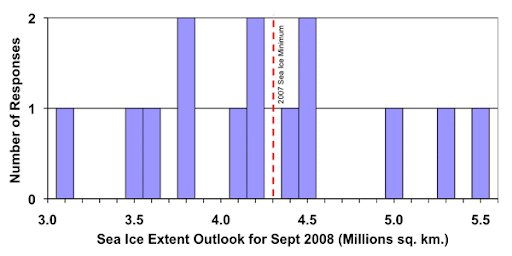Polar ice "loss" allegedly heralds a change in the weather
1. CU-Boulder Researchers Predict 59 Percent Chance Of Record Low Arctic Sea Ice In 2008

...Experts expected the winter of 2007-2008 to bolster the sea ice and hold the 2008 minimum well above the record low. Instead, the 4.52 million square kilometers of ice recorded on September 12, 2008 was just 10 percent shy of the record minimum. These numbers make for good press, experts say, but the real focus should be on the overall trend towards ice-free summers in the Arctic.Ok, so was this summer's minimum of about 4.7 (not 4.5) million square kilometers really less than "experts" expected?
"In a lot of ways, this year is more remarkable than last year," Meier said. Cooler temperatures and cloudier skies kept the ice from reaching another record, but scientists were looking for those factors to help the ice to regain some of the area it lost last year. This summer's extent, he said, was not the significant rebound he and his colleagues were expecting.
1. CU-Boulder Researchers Predict 59 Percent Chance Of Record Low Arctic Sea Ice In 2008
April 30, 20082. Also note that the purported minimum of about 4.7M square kilometers is actually HIGHER than 11 of 14 "expert" predictions from June 2008:
New University of Colorado at Boulder calculations indicate the record low minimum extent of sea ice across the Arctic last September has a three-in-five chance of being shattered again in 2008 because of continued warming temperatures and a preponderance of younger, thinner ice.
The forecast by researchers at CU-Boulder's Colorado Center for Astrodynamics Research is based on satellite data and temperature records and indicates there is a 59 percent chance the annual minimum sea ice record will be broken this fall for the third time in five years. Arctic sea ice declined by roughly 10 percent in the past decade, culminating in a record 2007 minimum ice cover of 1.59 million square miles. That broke the 2005 record by 460,000 miles -- an area the size of Texas and California combined.
"The current Arctic ice cover is thinner and younger than at any previous time in our recorded history, and this sets the stage for rapid melt and a new record low," said Research Associate Sheldon Drobot, who leads CCAR's Arctic Regional Ice Forecasting System group in CU-Boulder's aerospace engineering sciences department. Overall, 63 percent of the Arctic ice cover is younger than average, and only 2 percent is older than average, according to Drobot.




No comments:
Post a Comment